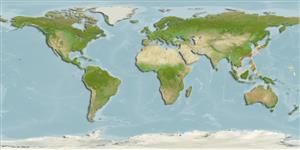Bivalvia |
Myida |
Teredinidae
Environment: milieu / climate zone / пределы глубины / distribution range
экология
. Subtropical
Indo-Pacific.
Length at first maturity / Size / Weight / Возраст
половая зрелость: Lm ? range ? - ? cm
May reach a length of 155 cm and a diameter of 6 cm. Found intertidal in mangrove mud (Ref. 53). Giant bivalve that burrows in black, organic-rich sediments in a marine bay, setting it apart from wood-boring shipworms. Descended from wood-feeding ancestors. Feeds by harboring sulfur-oxidizing chemoautotrophic (thioautotrophic) bacteria in contrast with other shipworms which use cellulolytic symbionts to obtain nutrition from decaying wood (Ref. 114919).
Life cycle and mating behavior
половая зрелость | размножение | нерест | Eggs | Fecundity | Larvae
Members of the class Bivalvia are mostly gonochoric, some are protandric hermaphrodites. Life cycle: Embryos develop into free-swimming trocophore larvae, succeeded by the bivalve veliger, resembling a miniature clam.
Основная ссылка
ссылки | координатор | соавторы
Bernard, F.R., Y.Y. Cai and B. Morton 1993 Catalogue of the living marine bivalve molluscs of China. Hong Kong University Press, Hong Kong. 121 p. (ссылка 75831)
Статус Красного Списка МСОП
(ссылка 130435: Version 2025-1)
Статус СИТЕС (ссылка 108899)
Not Evaluated
CMS (ссылка 116361)
Not Evaluated
Угроза для людей
Использование человеком
| FishSource |
инструменты
дополнительная информация
Trophic EcologyFood items (preys)
состав пищи
потребление пищи
хищники
Population dynamicsрост
Max. ages / sizes
Length-weight rel.
Length-length rel.
Размерный состав
Mass conversion
численность
Life cycleразмножениеполовая зрелостьFecundityнерестEggsРазвитие икрыLarvae PhysiologyOxygen consumption
Human RelatedStamps, coins, misc.
ресурсы в Интернет
Estimates based on models
